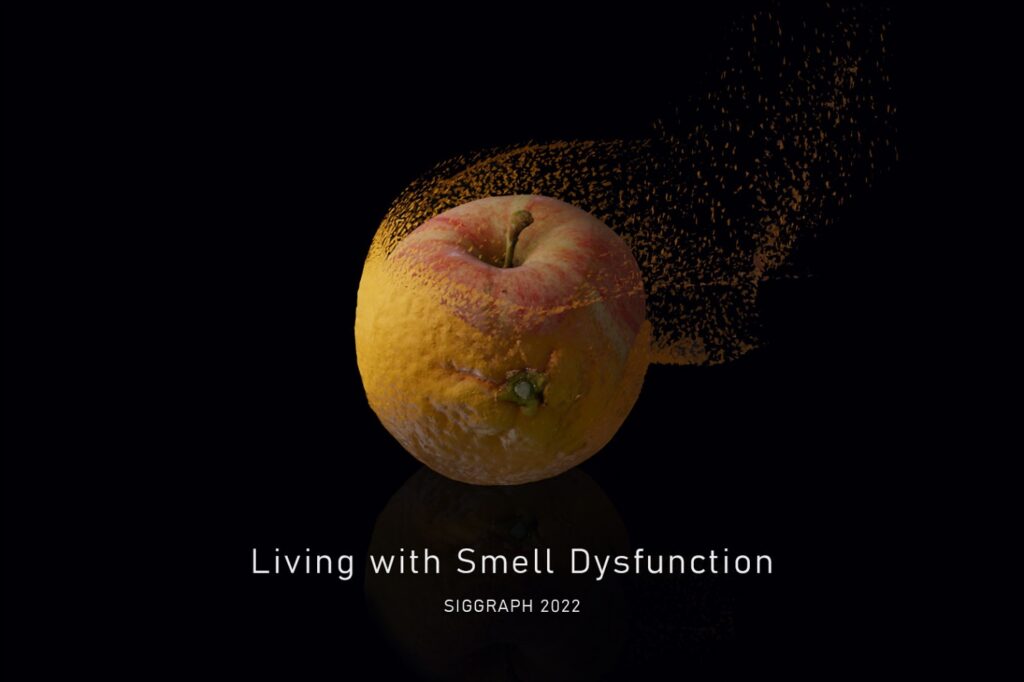The conference’s Emerging Technologies and Immersive Pavilion programs enable show-goers to experience innovation and experimentation in a direct, immersive way.

Technology is not just something to look at passively from arm’s length. It is also something that can—and often should—be experienced. Two of SIGGRAPH’s popular segments, the Emerging Technologies and Immersive Pavilion, allow just that.
This year, 26 research projects from more than 100 submissions from 27 countries have been selected as part of SIGGRAPH 2022’s Emerging Technologies and Immersive Pavilion programs, both of which are part of the conference’s Experience Hall. The chosen projects cover breakthroughs in the evolution of technology across many subfields of computer graphics and interactive techniques. In addition, there will be on-demand talks from researchers as part of the virtual conference available now through the end of October.
Emerging Technologies

Since the beginning, the SIGGRAPH community has comprised visionaries who look at technology to see not what it has done, but what it can do. That is the spirit behind the SIGGRAPH Emerging Technologies, which offers a look at the next generation of innovative technology that will shape our future. For years, it has been the SIGGRAPH venue that explores and demonstrates the “interactive techniques” portion of the ACM SIGGRAPH tagline “Special Interest Group on Computer Graphics and Interactive Techniques.”
“The 2022 program showcases the latest innovations in computer graphics and interactive techniques across some really interesting use case scenarios,” said SIGGRAPH 2022 Emerging Technologies Chair Mk Haley. “This year, we have a focus on both significant technical advancements and really interesting application scenarios. The installations will take attendees through experiences that celebrate sensations, accessibility, virtual displays, and even electrical muscle stimulation, just to name a few. The SIGGRAPH Emerging Technologies program continues to discover the next generation of contributors from around the world.”
Accessibility, whether it’s the technology that enables physical access to a space, overcoming geographical limitations, or systems that allow ease of use for creators to design with advanced tools and processes, was one theme that emerged this year. “The world and the opportunities in it are getting easier to share and participate in due to these creative and technological advancements,” Haley added.
Highlights from the Emerging Technologies program that will be showcased in Vancouver include:
Waving Blanket: Dynamic liquid distribution for multiple tactile feedback using rewireable piping system
Contributors: Ping-Hsuan Han, Yu-Yen Chen, Wu-Ting Pan, Hui-Wen Hsu, Jin-Rong Jiang, Wen-Jun Wu, National Taipei University of Technology
Perceiving multiple tactile sensations in VR is one of the keys to enabling a compelling, immersive experience. This paper presents Waving Blanket, which is a result of their goal to provide several stimulations in one technique to reduce the effort to integrate haptic devices.
ReQTable: A square tabletop display that provides dual-sided midair images to each of four users
Contributors: Mizuki Takenawa, Tomoyo Kikuchi, Yuchi Yahagi, Shogo Fukushima, Takeshi Naemura, The University of Tokyo
This paper proposed an optical system displaying dual-sided mid-air images to each of the fours users. In this study, they proposed methods to suppress unwanted light (stray light) by using linear polarizer and VCFs.
Demonstrating electrical head actuation: Enabling interactive systems to directly manipulate head orientation
Contributors: Yudai Tanaka, Shan-Yuan Teng, Jun Nishida, Pedro Lopes, University of Chicago
This research demonstrates a novel interface concept where interactive systems directly manipulate the user’s head orientation through two applications: finding visual targets in mixed reality while the system guides their point-of-view; a VR roller-coaster where the user’s head nods up as the ride accelerates.
Sense of embodiment inducement for people with reduced lower-body mobility and sensations with partial-visuomotor stimulation
Contributors: Hyuckjin Jang, Taehei Kim, Seoyoung Oh, Jeongmi Lee, Sunghee Lee, Sang Ho Yoon, Korea Advanced Institute of Science and Technology (KAIST)
During this research, they demonstrate an upper-body, motion tracking based, partial-visuomotor technique to induce sense of embodiment (SoE) for people with reduced lower-body mobility and sensation (PRLMS) patients. As a result of the methods, they found the potential positive effect of partial-visuomotor on SoE in the asynchronous VR experience of PRLMS.
Immersive Pavilion

The Immersive Pavilion is one of the more recent programs added to the SIGGRAPH conference and exhibition, but it has becoming especially popular, particularly with the rise of AR, VR, and MR, which have advanced the ways people communicate, create, learn, and play.
“For 2022, the Immersive Pavilion will highlight research that shows exciting and novel use cases for working in the metaverse, immersive gameplay, live VR performances, and exploratory use cases of augmented hardware, by covering several aspects of VR, AR, and mixed reality,” said SIGGRAPH 2022 Immersive Pavilion Chair Derek Ham. “It’s exciting to see how technologies push the boundaries to help advance the way we communicate, create, and learn.
Highlights from the 2022 Immersive Pavilion include:
Journal of My Journey: Seamless interaction in virtuality and reality with digital fabrication and sensory feedback
Contributors: Miguel Ying Jie Then, Ching Lui, Yvone Tsai Chen, Zin Yin Lim, Ping Hsuan Han, National Taipei University of Technology
This research explores the possibilities of integrating seamless interactions in virtuality and reality. They let the choices that the users make in the virtual world be output to the real world, thus enhancing the connection between the reality and the virtual world.
Mixed reality collaboration for complementary working styles
Contributors: Keru Wang, Zhu Wang, Karl Rosenberg, Zhenyi He, Dong Woo Yoo, Un Joo Christopher, Ken Perlin, NYU Future Reality Lab/Courant Institute
This project combines immersive VR, multitouch AR, real-time volumetric capture, robotically actuated tangible interfaces at multiple scales, spatial audio, and live coding in service of a human-centric way of collaborating. Bring your own unique talents and preferences to tackle these complex problems together in a shared, mixed-reality world.
Delirious departures
Contributors: Isjtar Vandebroeck, Eric Joris, Crew
This nomadic untethered VR experience combines socially intelligent avatars, a live actor, and awe-inspiring environments to diffuse technology developed within the PRESENT EU Horizon 2020 research project. This one-on-one performance builds on animation and crowd simulation technology developed by Inria and Cubic Motion (Epic Games).
In search of the plastic image: A media archaeology of scan processing living with smell dysfunction: a multi-sensory VR experience
Contributors: Yuting Wang, Ziqing Li, BroadAR
This project is an immersive multi-sensory VR experience that explores the everyday struggles of those with invisible disabilities, such as smell dysfunction. Using novel techniques of movement capture, real-time scent mapping, animations, and 360-degree videos, “Living with smell dysfunction” puts the audience into the shoes of an everyday life of a person with a smell disorder.
“Madrid Noir”
Contributors: James Castillo, Luke Gibbard, Jack Shaw, No Ghost; Antoine Cayrol, Atlas V
Join Lola, a disenchanted, young women who arrives in Madrid to empty her estranged uncle’s apartment after he is declared dead, to immerse yourself in an interactive VR experience inspired by film noir. This 45-minute mystery adventures unfolds across two acts in this VR film.
Made in Brooklyn Games
Contributors: Hessvacio Hassan, Alicia Marisal, Made in Brooklyn Games; Manny Marquez, JustChop Animation; Niko Korolog, Niko Korolog Music; Olga Andreyeva, Xantara
The Museum Multiverse experience encompasses an abandoned and sealed-off museum, a microcosm of society’s diminished view of minority artists, and history’s selective amnesia toward contributions of people of color during this immersive experience. The hope is to rectify the injustice of the under-representation these artists receive in mainstream popular culture and to give a voice to the unheard and the forgotten.
Access to SIGGRAPH 2022 Emerging Technologies and Immersive Pavilion programming is available at varying registration levels.





